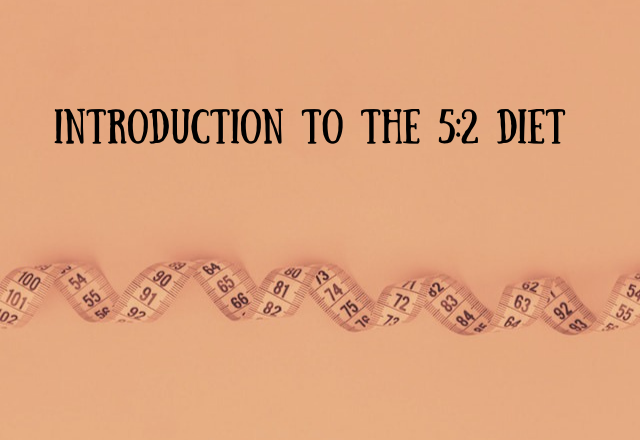Introduction to the 5:2 Diet

This Popular Form of Intermittent Fasting Lets You Eat ‘Normally’ Five Days Per Week
There have been thousands of different diets suggested over the years.
Many are in fashion for a while before they disappear to be replaced by a yet another ‘new’ idea.
While many of those diets are based on strict calorie consumption, intermittent fasting is a different way of approaching weight loss. This is not only becoming hugely popular – it has split into multiple variations. What is more, it seems to be having an impact.
The most popular way to get started with intermittent fasting is the 5:2 diet.
This introduction to the 5:2 diet starts by explaining exactly what it is and how it works. Next, the benefits you can enjoy from this technique are discussed, as well as a look at why some people can find it tough. The post ends with a look at other fasting methods which have proved to be successful.
How the 5:2 Diet Works
The premise of the 5:2 diet is that you eat as you usually would for 5 days a week. On the other two days, you dramatically decrease the calorie intake to around just 500-600 calories.
While it is called a ‘diet’, you could also consider it to be a lifestyle.
In this diet you won’t be counting calories throughout the week, you just simply have two days in the week where you cut your calorie consumption dramatically. The two ‘fasting’ days should be non-consecutive, with many practitioners of the diet using Monday and Thursday as the two fasting days (leaving the weekend to be free to eat as normal).

Don’t Binge on Non-Fasting Days on the Five Two Diet
It is important to eat normally on those non-fasting days. If you binge eat on those days, it can have a negative effect.
On the fasting days it is important to eat foods that are high in nutrients. This will keep you feeling full, as well as energised throughout the day. Fish, eggs, soups, meats, and vegetables are recommended on these days. Whether you split the food into two larger meals, or three smaller meals is personal choice, the decision of which can be based on your personal lifestyle.
Hydration is hugely important. Many foods naturally contain water, so if you are cutting the calories and the food intake, ensure to be drinking plenty of water throughout those days. Dehydration can cause both fatigue and headaches.
Benefits of the 5:2 Diet
There are a number of benefits that you can enjoy when participating in the 5:2 diet.
- Weight Loss: The most obvious impact of the 5:2 diet is a decrease in your body weight. Intermittent fasting promotes fat burning as well as weight loss and has shown to also increase your metabolic rate. An increased metabolic rate means more calories burned.
- Lower Insulin Levels: Intermittent fasting has shown to lower both blood sugar levels and insulin. This will aid in diabetes prevention.
- Improving Brain Functions: Studies have demonstrated beneficial effects of regular exercise and intermittent energy restriction/fasting on cognitive function and mood.
- Overall Health: Fasting has shown to be beneficial for cardiovascular health, including lowering blood pressure and levels of cholesterol.
Are There Downsides of the 5:2 Diet?
The main difficulty of participating in the 5:2 diet is obviously dealing with the two fasting days. Cutting down to 500/600 calories a day is a dramatic lifestyle change and can be very difficult to do in practise. You are going to be hungry. As suggested earlier, if you ear nutrient rich foods and ensure you are hydrated throughout, it will become easier to deal with. Once you have got into the routine of the 5:2 diet, it does seem more natural and will become easier to deal with.

Other Popular Intermittent Fasting Methods
Starting with 5:2 fasting will give your health a boost. Once you feel those benefits, the natural next step is to look into other forms of intermittent fasting. This is a deep rabbit hole, with daily methods, longer fasts and many other variations to try. The three options below will give you ‘food for thought’.
The 16:8 Method:
If fasting on two days a week isn’t for you, the 16:8 method can be another beneficial method. This requires you to eat within an 8-hour window daily, with no calorie intake in the other 16 hours of the day. For example, you could ensure that all of your meals on a given day are eaten between 10am and 6pm. Between 6pm and 10am the next morning, there is a 16-hour window where you are effectively fasting.
Alternate Day Fasting:
This is similar to the 5:2 diet, just a little more intensive. This method requires you to fast every other day (some will do this using a 4:3 method, which means they fast on the same days each week).
The Warrior Diet:
This is a more extreme version of the 16:8 method. In the Warrior Diet you have only a 4-hour eating window on a daily basis, with a small amount of raw fruits and vegetables in between.

Wrapping Up: Intermittent Fasting and the 5:2 Diet
Personally, I have an 18:6 cycle of lunch and dinner, with negligible high GI carbs all week. I then have a cheat day on Fridays (carbs allowed!). Key to the benefits of intermittent fasting is to find a cycle which works for you. Will power alone will last you for a week. A cycle which you enjoy – and feel the health benefits from is a longer-term proposition.
More Healthy Eating Pages: